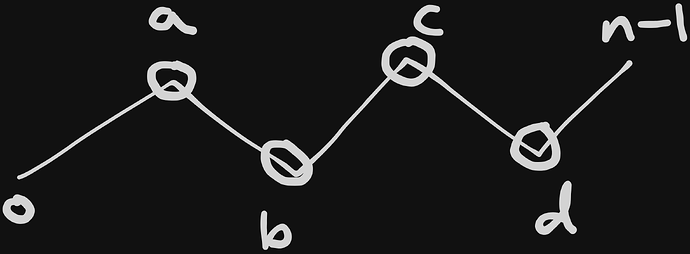PROBLEM LINK:
Practice
Contest: Division 1
Contest: Division 2
Contest: Division 3
Contest: Division 4
Author: manasagarwal12
Tester: sushil2006
Editorialist: iceknight1093
DIFFICULTY:
Simple
PREREQUISITES:
None
PROBLEM:
There are N mountain peaks in a line, with heights H_1, H_2, \ldots, H_N.
Adjacent peaks differ by exactly 1.
There’s one person standing at every mountain peak.
A person can move to an adjacent mountain peak, but only if it’s a height that hasn’t been visited before.
Two people are considered friends if they can meet each other at the same peak.
Find the number of friends.
EXPLANATION:
Let’s call mountain peak i a maxima if H_i \gt H_{i-1} and H_i \gt H_{i+1}.
Similarly, let’s call it a minima if it’s smaller than both neighbors.
We’ll call a peak extreme if it’s either a maxima or a minima.
Observe that because adjacent differences are equal to 1, it’s not possible for anyone to cross from one side of an extreme peak to the other side.
For example, to cross a maxima you’d have to go x \to x+1 \to x which is not allowed.
Now, let’s look at two people i and j (i \lt j).
Observe that:
- If there are no extreme peaks between i and j, they can definitely meet each other (for example i can just move towards j, and will never see a repeated element).
- If there’s exactly one extreme peak strictly between them (i.e. some k with i \lt k \lt j is extreme) , they can still meet, by both moving to that peak.
- If there are two or more extreme peaks between them, they cannot meet at all.
This is because i cannot cross the nearest extreme peak to his right, while j cannot cross the nearest extreme peak to his left. Since these are different extremes, it’s impossible for them to ever meet.
So, two people can meet if and only if there’s at most one extreme peak strictly between them.
Now, we need to count the number of such pairs of people.
Let’s define \text{next}[i] to be the next index of an extreme peak to the right of i.
This is easy to compute:
- If i+1 is extreme, then \text{next}[i] = i+1.
- Otherwise, \text{next}[i] = \text{next}[i+1].
Now, suppose we fix person i, and want to count the number of people j (with j \gt i) that can be reached.
Then,
- The first extreme to the right of i is at \text{next}[i].
- The second extreme to the right of i is at \text{next}[\text{next}[i]].
- Anyone beyond \text{next}[\text{next}[i]] cannot be reached, since there will be two extreme peaks between them.
So, the people who can be visited are exactly the range [i+1, \text{next}[\text{next}[i]]].
Simply add the length of this range to the answer for all i to obtain the overall answer.
TIME COMPLEXITY:
\mathcal{O}(N) per testcase.
CODE:
Editorialist's code (C++)
// #include <bits/allocator.h>
// #pragma GCC optimize("O3,unroll-loops")
// #pragma GCC target("avx2,bmi,bmi2,lzcnt,popcnt")
#include "bits/stdc++.h"
using namespace std;
using ll = long long int;
mt19937_64 RNG(chrono::high_resolution_clock::now().time_since_epoch().count());
int main()
{
ios::sync_with_stdio(false); cin.tie(0);
int t; cin >> t;
while (t--) {
int n; cin >> n;
vector a(n, 0);
for (int &x : a) cin >> x;
vector<int> mark(n, 0), jump(n, n);
mark[n-1] = 1;
jump[n-1] = n;
for (int i = n-2; i >= 0; --i) {
if (mark[i+1]) jump[i] = i+1;
else jump[i] = jump[i+1];
if (i) {
mark[i] |= a[i] > a[i-1] and a[i] > a[i+1];
mark[i] |= a[i] < a[i-1] and a[i] < a[i+1];
}
else mark[i] = 1;
}
ll ans = 0;
for (int i = 0; i < n; ++i) {
if (jump[i] == n or jump[jump[i]] == n) ans += n - i - 1;
else ans += jump[jump[i]] - i;
}
cout << ans << '\n';
}
}
Author's code (C++)
#include<bits/stdc++.h>
#define ll long long
using namespace std;
ll solve3(vector <ll> a,ll n){
vector<ll>vis(n+1,0);
vector<ll>pref(n,0);
int j=-1;
map<int,int>mp;
mp[a[0]]=0;
for(int i=1;i<n;i++){
if(mp.find(a[i])!=mp.end()){
j=max(j,mp[a[i]]);
mp[a[i]]=i;
}
else
mp[a[i]]=i;
if(j!=-1)
pref[j]++;
}
for(int i=n-2;i>=0;i--)
{
pref[i]+=pref[i+1];
}
j=n;
mp.clear();
mp[a[n-1]]=n-1;
ll ans=0;
for(int i=n-2;i>=0;i--){
if(mp.find(a[i])!=mp.end()){
j=min(j,mp[a[i]]);
mp[a[i]]=i;
}
else
mp[a[i]]=i;
if(j==n)
{
// cout<<n-1-i<<endl;
ans+=n-1-i;
}
else{
ans+=n-1-pref[j-1]-i;
}
}
return ans;
}
int main() {
int t;
cin>>t;
while(t--){
ll n;
cin>>n;
vector<ll> a(n);
for(int i=0;i<n;i++)
cin>>a[i];
cout<<solve3(a,n)<<endl;
}
}
Tester's code (C++)
#include <bits/stdc++.h>
#include <ext/pb_ds/assoc_container.hpp>
#include <ext/pb_ds/tree_policy.hpp>
using namespace std;
using namespace __gnu_pbds;
template<typename T> using Tree = tree<T, null_type, less<T>, rb_tree_tag, tree_order_statistics_node_update>;
typedef long long int ll;
typedef long double ld;
typedef pair<int,int> pii;
typedef pair<ll,ll> pll;
#define fastio ios_base::sync_with_stdio(false); cin.tie(NULL)
#define pb push_back
#define endl '\n'
#define sz(a) (int)a.size()
#define setbits(x) __builtin_popcountll(x)
#define ff first
#define ss second
#define conts continue
#define ceil2(x,y) ((x+y-1)/(y))
#define all(a) a.begin(), a.end()
#define rall(a) a.rbegin(), a.rend()
#define yes cout << "Yes" << endl
#define no cout << "No" << endl
#define rep(i,n) for(int i = 0; i < n; ++i)
#define rep1(i,n) for(int i = 1; i <= n; ++i)
#define rev(i,s,e) for(int i = s; i >= e; --i)
#define trav(i,a) for(auto &i : a)
template<typename T>
void amin(T &a, T b) {
a = min(a,b);
}
template<typename T>
void amax(T &a, T b) {
a = max(a,b);
}
#ifdef LOCAL
#include "debug.h"
#else
#define debug(...) 42
#endif
/*
*/
const int MOD = 1e9 + 7;
const int N = 1e5 + 5;
const int inf1 = int(1e9) + 5;
const ll inf2 = ll(1e18) + 5;
void solve(int test_case){
ll n; cin >> n;
vector<ll> a(n+5);
rep1(i,n) cin >> a[i];
vector<ll> b(n+5);
rep1(i,n) b[i] = a[i] < a[i+1];
b[n] = -1;
vector<ll> nxt(n+5,n);
rev(i,n-1,1){
if(b[i] == b[i+1]) nxt[i] = nxt[i+1];
else nxt[i] = i;
}
ll ans = 0;
rep1(i,n-1){
ll j = i-1;
rep1(iter,2){
j++;
j = nxt[j];
}
amin(j,n-1);
ans += j-i+1;
}
cout << ans << endl;
}
int main()
{
fastio;
int t = 1;
cin >> t;
rep1(i, t) {
solve(i);
}
return 0;
}
